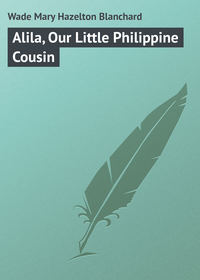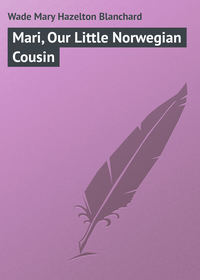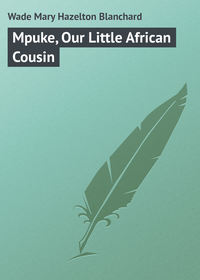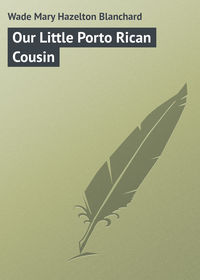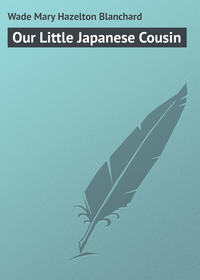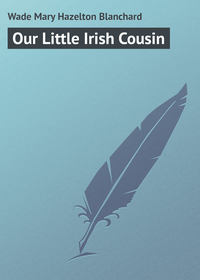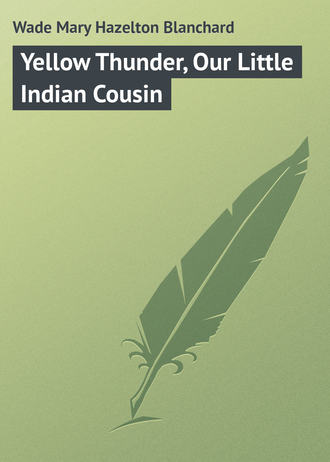 полная версия
полная версияYellow Thunder, Our Little Indian Cousin

Mary Hazelton Wade
Yellow Thunder, Our Little Indian Cousin
Once upon a time, as you doubtless know, there were no white people in the Western world. In those days our Indian cousins were free to wander wherever they wished, from the Atlantic to the Pacific.
Some of them had their homes on the great plains, where herds of wild buffaloes supplied them with food and clothing. Others dwelt by the shores of lakes and rivers. Whenever they wished a change, they moved their camps from one spot to another. They had little to fear except the attacks of unfriendly tribes of their own race.
When the white men, with their greater skill and knowledge, came to America, many troubles began for our red cousins. These troubles were such as they had never known before. They were driven away from the homes that were so dear to them. Great numbers were killed. Strong drink, given to them by the white strangers, was the ruin of thousands. Still others died from sickness and want.
The people whom we have called Indians ever since Columbus gave them that name now think with sadness of the old free and happy days before the white traders gave them beads and blankets in exchange for large tracts of land.
There were then no roads, no cities, no stores or factories in all this vast continent, and yet our red cousins were freer and happier than they can ever hope to be again.
Malden, Mass., May, 1904.
YELLOW THUNDER
Our Little Indian Cousin
They call him Yellow Thunder. Do not be afraid of your little cousin because he bears such a terrible name. It is not his fault, I assure you. His grandmother had a dream the night he was born. She believed the Great Spirit, as the Indians call our Heavenly Father, sent this to her. In the dream she saw the heavens in a great storm. Lightning flashed and she constantly heard the roar of thunder. When she awoke in the morning she said, "My first grandson must be called 'Yellow Thunder.'" And Yellow Thunder became his name.
But his loving mamma does not generally call him this. When he is a good boy and she is pleased with him, she says, "My bird." If he is naughty, for once in a great while this happens, she calls him "bad boy."
For some reason I don't understand myself, she rarely speaks his real name. Perhaps it is sacred to her, since she believes it was directed by the Great Spirit.
Yellow Thunder lives in the forests of your own land, North America. His skin is a dull, smoky red, his eyes are black and very bright, his hair is black and coarse. His body is straight and well formed. He can run through the woods as quickly and softly as a deer. He lives in a bark house made by his mother. His father is strong and well, yet he did not help in building it. He thinks such work is not for men. It is fit only for women.
When I tell you how it is made, you will not think it is very hard work. Yellow Thunder's patient mamma chose the place for her home, and then gathered some long poles in the forest. She set these poles in a circle in the ground, bent them over at the top, and tied them. She left a small hole at the top. The framework of the house was now complete. What should she have for a covering? She went out once more into the woods and got some long sheets of white birch bark. At the end of each sheet she fastened a rim of cedar wood. The sheets of bark were hung on the framework, with the rim at the bottom of each one, and the house was finished. The rim would be useful in keeping the bark from being lifted by the winds. But, if there should be a severe storm, the Indian woman would lay stones on the rims to keep the bark down more firmly still.
This is Yellow Thunder's simple home, summer and winter. You would probably freeze there in the cold days of December, but the Indian boy was brought up to endure a great deal of cold.
Let us look inside. We must first lift the deerskin which hangs in the doorway. Does the family sit on the cold, bare ground, do you think? Oh, no; Yellow Thunder has helped his mamma make good thick rugs out of the bullrushes and flags which they gather every autumn. These rugs are very pretty, for they are woven and dyed with the bright colours the Indian women know how to make. There are many of these mats, because they are used for many purposes. Yellow Thunder sleeps on one of them at night. In the day-time he sits on a mat whenever he is in the house. But he is such a strong lad, he is out-of-doors nearly all the time, both in sunshine and in storm.
In the middle of the house you will notice there is a bare spot covered with clean sand. This is the place where the fire is made. It is carefully swept when there is no fire. If you look directly over the fireplace, you can see the sky. On rainy days, unless the mother is cooking, she keeps the hole covered with a piece of deerskin, that the inside of the house may be dry.
But how does she prepare the food for breakfast, for that is the principal meal of the day to the Indian? A strong hook is fastened in the framework of the house, above the fireplace. The Indian mother hangs a pot on the hook, puts in the meat or fish, and it boils quickly over the burning twigs which her little boy has gathered.
Let us look around the wigwam. Of course, you have long ago heard that name for the Indian's house. What beautiful baskets of rushes those are! I wonder how the red men discovered the way of making such beautiful colours. Besides many other things, the jewelry and clothing of the whole family are kept in these baskets. Look up at the sides of the hut and notice the bows and arrows. And, yes! there is a real tomahawk, with its sharp edge sticking in that corner. Ears of corn braided together are hanging from the framework.
But the prettiest thing we see is the baby's cradle, fastened to a peg. Two bright black eyes are looking out of it, and that is all we can see of Yellow Thunder's baby sister, "Woman of the Mountain." It took the loving mother a long time to make that cradle. She was very happy while doing it, for she loves her baby tenderly.
It is hardly right to call it a cradle. Baby-frame is a better name. It was made in three pieces, out of the wood of the maple-tree, – a straight board about two feet long for the bottom, a carved foot-board, and a bow which is fastened to the sides and arches over the baby's head. These are all bound together with the sinews of a deer. It is lined with moss, and then Woman of the Mountain is fastened in her queer little bed with straps, which her mamma has made beautiful with bead work. Moss is placed between her feet, her hands are bound at her side, her feet are bound down also, and a beaded coverlet is placed over her tiny body. She looks like a little mummy.
If it is stormy she is hung up on a peg in the hut to swing, but if it is a pleasant day, she swings on the branch of a tree and watches the leaves flutter and the birds sing. She is a happy little baby, although you would hardly think it possible. She got used to her imprisonment almost as soon as she was born. She doubtless thinks it is all right.
When mamma goes out into the forest to gather wood, or into the corn field to work, Woman of the Mountain goes too. The baby-frame is fastened on her mother's back by a pretty beaded strap bound over the woman's forehead.
When the Indian baby was only two days old, she was fastened into her cradle and carried all day on mamma's back while she was weeding the garden. To be sure, the woman stopped two or three times to feed her baby, but the little thing was not once taken out of her frame.
Perhaps you would like to hear a lullaby the Indian mamma often sings to her little one as she swings in her frame. I fear you could not understand the Indian words, so I will give them as Mrs. Elizabeth Oakes Smith wrote them in English:
Swinging, swinging, lul la by,Sleep, little daughter, sleep,'Tis your mother watching by,Swinging, swinging, she will keep,Little daughter, lul la by.'Tis your mother loves you, dearest,Sleep, sleep, daughter, sleep,Swinging, swinging, ever nearest,Baby, baby, do not weep;Little daughter, lul la by.Swinging, swinging, lul la by,Sleep, sleep, little one,And thy mother will be nigh —Swing, swing, not alone —Little daughter, lul la by.You can understand from this how dearly the Indian mother loves her baby, – just as dearly, I do not doubt, as your own mamma has always loved and cared for you.
But what is Yellow Thunder's stern-looking father doing all the time? He has no store to keep, no mill to grind, no factory to work in. There are only three things which deserve his attention. At least that is what he thinks. He hunts or fishes, goes to war, and holds councils with the men of his tribe. Everything else he believes is woman's work, and from the Indian's standpoint, woman is much beneath a man.
After all, the men's work is really the hardest. Sometimes it is easy for them to find plenty of food. Then Yellow Thunder's father comes home rejoicing with the big load he carries. Perhaps he has a red deer hanging over his shoulder; perhaps it is a bear which he has chased many miles before he could get near enough to kill it; or it may be some raccoons for a delicious stew.
But, again, it may be stormy weather. The rivers are frozen over and snow covers the ground. Then, perhaps, the hunter has little success with his bow and arrow, and searches long and far before he can find anything to satisfy his children's hunger. He feels sad, but not for a moment does he think of complaining or giving up. It is his duty to obtain food for his family. It does not matter how cold he gets or how wet he may be. He keeps travelling onward. He will not give up. If he does not at last get enough for all, he will insist on his wife and children satisfying their hunger first. He would scorn to show that he himself is tired, or hungry, or suffering in any way.
We can understand now why the Indian baby is pinned down in its cradle and not allowed to move freely. It is its first lesson in endurance. It must learn to be uncomfortable and not to show that it is so. It must learn to bear pain, and neither cry nor pucker its mouth. It must learn to appear calm, no matter how it feels.
The hunt is pleasant sometimes, you see, but at others it is work of the hardest kind.
The second duty of the red boy's father is war. He must protect his home from human and wild beast enemies. But I'm really afraid that it is a pleasure for him to fight. If Indians had not been at war so much among themselves, it would have been far harder for the white people to conquer them. I suppose you children have all heard the story of the bundle of sticks, but I will repeat it.
A certain man was about to die. He gathered his sons around him to give them good advice. He showed them some sticks fastened tightly together. Then he asked each one to try to break the bundle. No one could do it. When he saw that they failed, he separated the sticks, and showed them how easy it was to break each one by itself.
"Take a lesson from this," said the man. "If you are united and work together, you will succeed in anything you undertake, for no one can break your strength. If, however, you quarrel among yourselves and try to work each for himself, you will be like the separate twigs, – easily broken."
It has been like this with the Indians. They have fought against each other, tribe with tribe. They are very brave and have great courage. But they have not understood that they should work together. So the white man came and was able to conquer them.
Besides hunting and going to war, Yellow Thunder's papa is often busy in the council. All matters of business are settled here. New chiefs are chosen at the council; wrong-doers are punished according to what it decides, and treaties with other tribes or the white men are talked over and agreed upon. Sometimes a council will last many days. It is always opened with a prayer to the Great Spirit, thanking him for his good gifts to the people. Each evening, after the business of the council is over, games are played by old and young. It is a time for feasting and pleasure. No business with other people is really settled by a council without gifts of wampum to bind the bargain. Of course you have heard about wampum. Perhaps you have been told it is the Indian's money. There are two kinds of wampum. One is purple and the other white. The white wampum is shaped into beads out of the inside of large conch shells, while the purple is made from the inside of the mussel shell. These beads are strung on deer's sinews and woven into belts. A belt of white wampum is a seal of friendship between two tribes. It is the same as a sacred promise which must not be broken. It is the most precious of all things an Indian owns.
Yellow Thunder's papa is very fond of tobacco. He always carries a beaded pouch filled with it. He believes that the Great Spirit gave tobacco to the Indian. When he smokes it, it opens a way through which he may draw near God, and be taught by him. His pipe and tobacco will be buried with him when he dies, as he thinks they will be needed on his journey toward heaven. He smokes at the council. He smokes around the camp-fire when he is away hunting. He smokes in the evening time as he sits with his friends and tells stories of the chase or listens to legends of his people.
I hardly know what this Indian father would do without his pipe, as it seems to give him so much comfort and pleasure.
See! here he comes now. Yellow Thunder is at the door of the lodge, watching him as he walks quickly down the forest path. He is truly called a "brave." He looks as though he would fear no danger. How straight is his body, and how strong are his muscles!
He wears leggings of deerskin, finely worked with beads. They are fastened just above his knees. A short kilt is gathered around his waist. It is also made of deerskin, but is worked around the edge with porcupine quills stained in several colours. It is bitterly cold to-day, so he wears a blanket over his shoulders. His head is shaved bare, excepting the scalp-lock at the back. It must be this which makes him look so fierce.
I want you to notice his feet. They step softly and yet firmly. You could not walk as he does. Perhaps you have pointed shoes with high heels. The Indian would look with scorn upon these. What! Cramp the toes with such uncomfortable things! Impossible! He covers his feet in the most sensible manner with the soft moccasins made by his wife. They fit his feet exactly. He can run like a deer, or creep along the ground like a wildcat in these coverings, and no one will hear him coming. Each moccasin is made of a single piece of deerskin, seamed at the heel and in front. The bottom is smooth and without a seam, while the upper part is worked with beads.
Yellow Thunder's good mamma uses a curious needle and thread. The needle is made from the bone of a deer's ankle, and her thread is of the sinews of the same animal. What would the Indian have done without the deer in the old days before the white man came to this country? I can't imagine, can you?
This animal furnished much of his food and clothing; ornaments were made of his hoofs; needles and many other things came from his bones. Even the brains of the creature were used in tanning skins of animals. They were mixed with moss, made into cakes, and dried in the sun. This mixture will keep a great length of time. Whenever it is needed, a piece of this brain-cake is boiled in water, and the skin is soaked in it after the hair is scraped off. Then it is wrung out and stretched until it is dry. But even then the skin is not ready for use. It will tear very easily. It must be thoroughly smoked on both sides. This work all belongs to Yellow Thunder's mamma. His father has nothing to do with it.
Suppose we follow the red man into his home. Ugh! What a smoke there is inside! We can hardly see across the wigwam. We shall need to lie down on the mat as the Indian does. Our eyes will be blinded unless we do this. The wife has a good meal waiting for her husband, but she will not eat till he has finished. That is Indian good manners.
His wooden bowl and plate, together with a boiled corn-cake, are placed on the mat in front of the man. Venison stew is served him out of the big pot, and a dish of sassafras tea is also set before him. There is no milk to put into this queer drink, but if he wishes to sweeten it, he can add some delicious maple syrup. This is certainly not a bad meal for any one.
The red man eats and drinks, while scarcely a word is said to his waiting family. When he has finished his meal, he will light his pipe for a quiet smoke, after which his wife and child satisfy their hunger.
Yellow Thunder's mamma knows how to prepare many a good dish. She can make several different kinds of corn bread. She prepares soups of deer and bear meat. She boils the hominy, on which our little red cousin pours the maple syrup. She makes teas of wild spices and herbs which grow near the hut. But these drinks are not likely to keep Yellow Thunder awake at night. Neither is there danger of his starving, so long as his father can hunt and his mother can gather her crops. His food is suited to make him strong and healthy, and he does not miss the dainties of which you are so fond.
The stern-looking father never thinks of interfering in the management of the home. That is his wife's right. She gives him his sleeping-place and the corner in which he shall put his belongings. She decides on what shall be cooked, and what shall be stored away. She is the ruler in the home.
But, on the other hand, he does not expect her to scold. She should always be obliging and happy in entertaining his friends. She should be ready to furnish him a good meal whenever he comes home.
As yet, he does not take much notice of his only son. He does not correct the boy's faults. He seldom takes him on his hunts. He has left all care of the boy to his wife up to this time.
But Yellow Thunder is now twelve years old. He will soon be a man. In a year or two, at most, his father will begin to make a companion of his son in hunting and fishing. He will teach him the ways of a brave Indian warrior. Then there will be no more woman's work for Yellow Thunder.
When the time comes for this great change in his life, he will go out into the forest to fast. No one will insist on his doing this. He will himself desire it. It is the same as a baptism to a young Indian. His father will go with him to the lonely spot where he decides to stay. He will give his son wise words of counsel. He will urge him to be brave and keep his fast as long as possible. He will be able to show by this how much courage and spirit he possesses, and how great a man he desires to be. Then he will leave his son alone and go back to the village.
A day passes by, and Yellow Thunder grows faint. Two days now are gone, and the boy's thirst is intense. At the end of three days his father comes back and finds his son lying weak and dizzy beneath the trees. He gives him a little water, but no food, for Yellow Thunder says he can fast still longer.
The father goes away again, leaving the son to watch for the visions which will surely come. It will be decided now what the red boy's future will be. The longer he can fast, the greater man he will become among his people. No one can be a chief unless he has fasted many days at the beginning of his manhood.
We cannot tell what Yellow Thunder will be, but we know that his visions will always be remembered. He believes that his guardian spirits will appear in some form or another to him, and he will get instruction about his future life. He will endure his fast bravely as long as possible.
It sometimes happens that Indian boys die at this time of fasting, but we feel sure that Yellow Thunder will live and be a joy to his parents to the end of their lives.
But how is the Indian mother preparing him for this great test? She teaches him, first of all, to obey. In no other way would it be possible for him to become a great man. He must heed everything that his father and mother tell him. He must always be ready to do their bidding. It is the greatest token of rudeness to appear curious, therefore he must ask no questions. He must love the truth. A lie is almost unknown among the Indians; they scorn it as the mark of a cowardly and mean nature. He must be brotherly to all creatures, and ready to give to others always.
Yellow Thunder has never seen a pauper or beggar in his life. Whenever any one comes to his home, his mother hastens at once to prepare food for the visitor. It is almost a law to her to do so. If relatives should come for a visit, they will be made welcome and allowed to stay as long as they desire. If they should remain for the rest of their lives, they would never be asked to leave. "Be hospitable to all," is a maxim planted in the heart of every Indian child.
Yellow Thunder is taught that everything should be shared in common. The Indian does not say, "My land." It is always "Ours." The people of a tribe are truly brothers to each other.
The red boy's mamma does not need to teach him that theft is wrong. It is almost unknown among his people. The idea of doing such an unbrotherly thing does not enter their heads. No wonder there are neither poorhouses nor prisons among these people. We call them savages, but there are many things we could copy with profit from them. Don't you think so, children? "Live and learn," is an old saying, and I think we would do well to remember it when we read the lives of our cousins in many lands.
Yellow Thunder does not go to church or Sunday school. I doubt if Sunday is any different to him from any other day. But his mamma has taught him that there is one loving Heavenly Father for all. If Yellow Thunder is good and brave, he will go to the "happy hunting-grounds" when he dies. At least, this is what he is taught to believe. There will be enough food and an abundance of animals to kill. Everything that the Indian loves best to do in this life, he thinks can be found in his heaven. But there is no place there for the white man. George Washington was the only white man who ever lived whom they thought fit to enter their paradise. The exception was made in his case because he was brave and good, and treated the Indians fairly and justly.
Yellow Thunder's mother often tells him of a prophecy which was made long ago by the wise men of her tribe. They said that a great monster, with white eyes, would come out of the East and consume the land. Did the prophecy come true, you ask? Yes, my dears, it was the white race.
When Yellow Thunder thinks of the great forests which his people once owned, and of the numbers of animals roaming there, when he remembers the wars which have been fought and lost with the "great monster," his heart grows bitter.
Don't blame him, children, but feel sorry for your little Indian cousin. His people have certainly had a hard time. They have been very cruel in warfare with us, but they felt they were treated unjustly, and we were taking their homes away from them.
Yellow Thunder believes in the Great Father, as I have told you. His mother has also taught him that there are many spirits, both good and bad. God made the good spirits to help him in his care of this great world. The Indian believes that the wind is a spirit of great power. The thunder is another spirit, whom he calls Heno. Heno makes the clouds and the rain. It is he who forms the thunderbolt and sends it to destroy the wicked.
The Great Spirit is very kind to give men such a helper, and when the harvest time comes, Yellow Thunder gives him thanks and prays to him that he will continue to send Heno into the world.
There is an old legend among the Indians that Heno once dwelt in a cave behind Niagara Falls. The mighty rushing noise of the water was pleasing to him.
Yellow Thunder pictures the Spirit of the Winds to himself. This spirit has the face of an old man who is always in the midst of discord, for the four winds are never at peace with each other.
Then there are the spirits of Corn, of Beans, and of Squash. Each one of these is looked upon as a friend of the red race, for these vegetables are prized by them above all others.
It is believed that these spirits have the forms of beautiful women, and that they dwell happily together and are very fond of each other.




